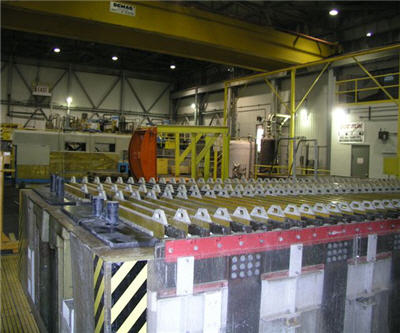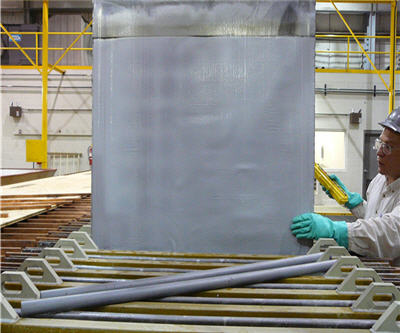
The lead smelting process is getting greener thanks to new technology unveiled recently by The Doe Run Company.
As one of the world’s largest lead producers, Missouri-based Doe Run has introduced a new hydrometallurgical process to replace centuries-old, high-temperature lead smelting. The company expects the process to transform the way primary lead metal is manufactured.
“This new proprietary technology is a game-changer for our industry,” says Doe Run president and CEO Bruce Neil, adding that the technology will result in cleaner communities, energy independence and satisfaction of growing demand for lead products.
Working with its technology partner, Engitec, Doe Run’s technology uses a wet chemical process to dissolve lead concentrates into solution, then extracts the lead from the solution using an electric current. The process is similar to the electrowinning process used to extract zinc from concentrates, but this is the first time it has been tried for lead production.

With Doe Run’s new hydrometallurgical lead smelting process, a proprietary lead-bearing solution is exposed to an electric current, which electrowins the lead metal to cathode sheets. A similar electrowinning process is used to extract zinc from concentrate, but it has never before been applied to primary lead production.
Doe Run has invested $30 million in proving the technology so far. It is currently running a demonstration plant in Missouri, wrapping up a feasibility study, and pursuing funding for a commercial plant, which is expected to cost $150 million and take 18 months to build.
Lead is primarily used in lead acid batteries, which make up 80 percent of world lead consumption. Lead acid batteries power automobiles and are also used as backup power for hospitals and other large buildings. Lead is used for medical and nuclear protective shielding and, increasingly, for wind and solar power storage.
Traditional lead smelting uses a centre plant blast furnace to break the lead-sulphur bond in the galena mineral. The sulphur dioxide gas is run through an acid plant for conversion into sulphuric acid that is sold to fertilizer manufacturers. The lead oxide is then heated in a coke-fuelled blast furnace up to 2,500 degrees Fahrenheit, which produces a liquid bullion. In the final stages, copper and silver co-products are removed, resulting in a pure lead product, or the lead is alloyed with other materials such as calcium, aluminum or tin.
The greatest advantage of traditional lead smelting is its familiarity; however, the process has a number of limitations. The use of natural gas to heat the coke in the blast furnace, as well as for refining and casting the lead, makes the process extremely energy intensive. The process generates slag heaps and also requires sophisticated and expensive emissions-capture systems to filter the gases.
In 2008, a stringent new air-quality standard was introduced in the United States. The National Ambient Air Quality Standard (NAAQS) reduced acceptable air-lead levels 10-fold, prompting Doe Run to embark on an ambitious R&D program that would allow the company to meet the new standards.
“We decided it wasn’t going to be economical to make the process modifications necessary to meet these new standards, so we started looking at alternative technologies,” says Doe Run chief operating officer Jerry Pyatt.
“We looked at other pyro processes that do a better job of capturing sulphur and lead emissions, but we couldn’t find technology that was capable of meeting those NAAQS standards.”
Instead, the company began testing a hydrometallurgical process that uses fluoboric acid as a reagent to dissolve the lead.
Pyatt explains it as a three-stage process.
In the first stage, lead concentrate produced from Doe Run’s six underground mines is introduced to leaching vessels filled with fluoboric acid. The acid dissolves the lead, while the co-products remain as solids and are dewatered.
Next, the liquid lead is fed into an electrowinning vessel, where low-voltage current is passed through a series of anode and cathode plates. The lead is then deposited onto cathode sheets.
In the last stage, co-products zinc, copper, silver and elemental sulphur are recovered using standard mineral processing methods.
Pyatt says that the process offers several environmental advantages, with the most important being an absence of slag heaps, along with virtually no air emissions. The low temperature means a substantially reduced carbon footprint due to low energy inputs. Importantly, the reagent (fluoboric acid) can be recycled for several years.
“The reagent is quite expensive so that is obviously a huge plus for the economics of the process,” says Pyatt, adding:
“We certainly believe there’s going to be substantial operating costs savings for this hydro process versus the smelting process we’re currently using.”
Doe Run notes that its new process allows for higher lead recovery rates than traditional smelting: 99 percent versus 95 percent.
Looking ahead, the company is bullish on the market for lead, particularly given the burgeoning Chinese market for automobiles requiring lead-acid batteries. It notes that, in 2009, Chinese lead demand was about 42 percent of world consumption, with demand in China growing by 12 percent in 2010, compared to 6 percent globally.
Doe Run forecasts global refined lead demand to grow from 9.3 million tones in 2010 to close to 17 million tonnes in 2025.
Pyatt says the new process has the potential not only to allow the lead industry to prosper, but also to build acceptance of lead as a safe metal among the general population, despite negative reports such as lead-tainted toys from China.
“We believe that this technology is a substantial step forward in comparison with any pyro process that’s out there to make lead metal,” he says. “And so if you can demonstrate to the world that you can make the metal and society can benefit from all the advantages that it brings, then I think society will embrace it.”
Links and References
As More Toys Are Recalled, Trail Ends In China
National Ambient Air Quality Standard (NAAQS)
The Doe Run Company: Metal Mining
Comments
Sulfur Mineral
Sulfur is essential for numerous processes that the human body goes via continually. Angstrom Sulfur can restore normal blood sugar levels as cells become permeable and helps restore pancreas functions to normal as the cells absorb blood sugar.